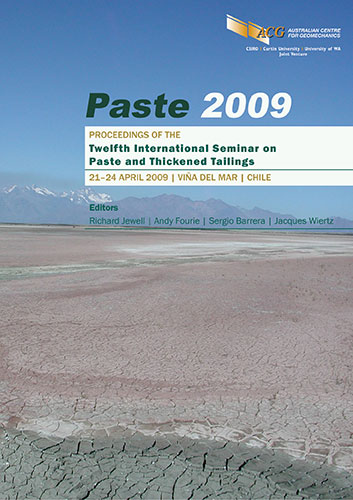An Investigation into the Effect of Operational Factors on Tailings Deep Cones Efficiency at Miduk Copper Complex

|
Authors: Garmsiri, MR; Haji Amin Shirazi, H Paper is not available for download Contact Us |
DOI https://doi.org/10.36487/ACG_repo/963_12
Cite As:
Garmsiri, MR & Haji Amin Shirazi, H 2009, 'An Investigation into the Effect of Operational Factors on Tailings Deep Cones Efficiency at Miduk Copper Complex', in R Jewell, AB Fourie, S Barrera & J Wiertz (eds), Paste 2009: Proceedings of the Twelfth International Seminar on Paste and Thickened Tailings, Australian Centre for Geomechanics, Perth, pp. 101-107, https://doi.org/10.36487/ACG_repo/963_12
Abstract:
The significance of dewatering and high capital cost of conventional thickeners considering installations and required surface area, lead to deep cone development. In comparison with conventional thickeners, diameter to height ratio of deep cones, having shorter diameter and greater depth, requires less area. Thus in spite of less surface area requirement, using deep cone results in 20–40% increase in recycled water. Being recently innovated, the effect of operational factors on deep cone thickener efficiency has not been reported. In this work the effect of sludge depth and flocculant dosage on underflow concentration of deep cones of Miduk copper complex was investigated. Then the effect of feed rate variation and feed solids per cent on deep cone efficiency was studied. It is shown that 4m increase in sludge depth contributed to 4% increase in underflow solids concentration. Increasing flocculant dosage resulted in decreasing underflow solids per cent, however in comparison with the effect of sludge depth, its impact is not considerable. In addition, 0.6% increase in feed solids per cent resulted in about 1% increase in underflow solids per cent. It is concluded that there is an optimum level for feed solids concentration, above which hindered settling is responsible for a reduction in settling rate and hence disturb deep cone operation, however its impact on underflow solids per cent is desirable.
References:
Gupta, A. and Yan, D.S. (2006) Mineral processing design and operation, Elsevier publication, Ch. 13.
Moudgil, B.M. and Baharat, D.S. (1986) Advances in solid-liquid separation, University of Florida, Gainesville,
Florida.
Owen, A.T., Fawell, P.D., Swift, J.D. and Farrow, J.B. (2002) The impact of polyacrylamide flocculant solution age on
flocculation performance, International Journal of Mineral Processing, Vol. 67, Elsevier publication,
pp. 123–144.
Peter, J., Bruce, J. and Simon, A.P. (2006) Floc structural characteristics using conventional coagulation for a high doc,
low alkalinity surface water source, Water Research Journal, Vol. 40, Elsevier publication, pp. 2727–2737.
Wills, B.A. and Napier-Munn, T. (2006) Mineral processing technology, Elsevier Science and Technology Books
publication, Ch. 15.
Paste 2009, Viña del Mar, Chile 107
© Copyright 2025, Australian Centre for Geomechanics (ACG), The University of Western Australia. All rights reserved.
View copyright/legal information
Please direct any queries or error reports to repository-acg@uwa.edu.au
View copyright/legal information
Please direct any queries or error reports to repository-acg@uwa.edu.au